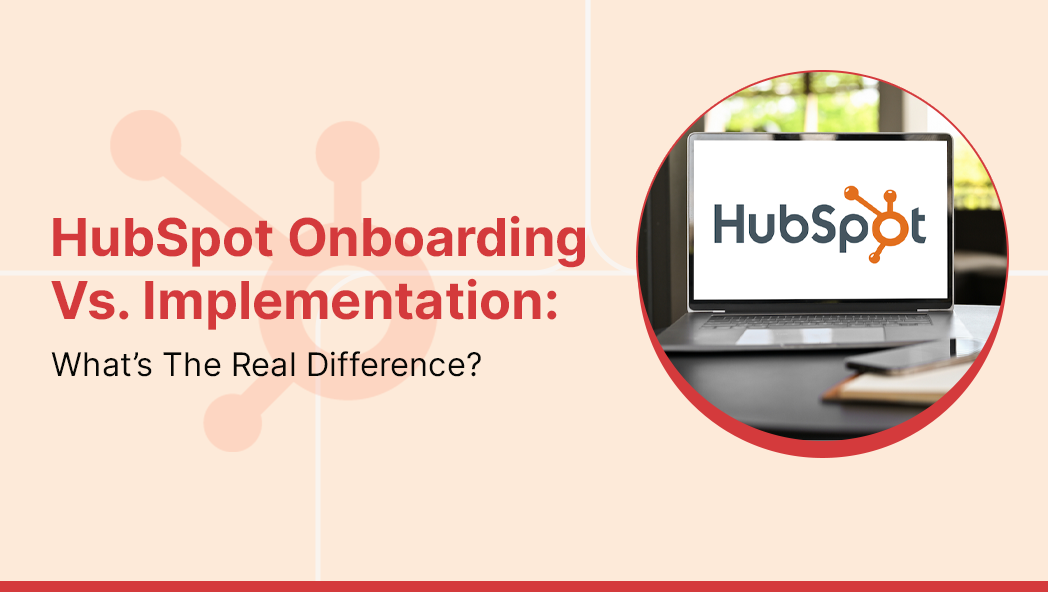Overview HubSpot is a powerful platform that supports marketing, sales and customer service teams...
written by: Renuka M
Overview
The minute you decide to bring HubSpot into your business, you will stumble upon two words - Onboarding and Implementation. At first glance, they both sound like the same thing, which is possibly why most people often use these terms interchangeably. However, the difference between the two couldn’t have been more drastic.
Integrating HubSpot into your business helps you transform how you attract, engage, and delight your customers. But getting your HubSpot up and running is where things get ultra confusing. While onboarding and implementation sound pretty much the same, in reality, these two offer very different approaches to adopting HubSpot.
In this comprehensive guide, we have tried to clearly highlight the difference between onboarding and implementation, so you can efficiently choose what is right for your business. Let’s dive straight to it -
What is HubSpot Onboarding?
HubSpot onboarding is the process where either HubSpot or a partner service provider helps businesses get started with the HubSpot tools. The goal here is to ensure that your HubSpot portal is ready to use, your teams understand the basic functionalities of the platform, and you can start utilising the platform’s features effectively.
Think of it as a guided tour, which is structured, time bound, and designed to help you understand the basics of HubSpot. You’ll learn where everything is placed, how various features work, and even receive guidance on some basic operations. Onboarding is more focused on educating and training your team so you can do the rest on your own, rather than doing it for you.
Key Activities in HubSpot Onboarding
A HubSpot onboarding process generally involves -
- Tech setup: This involves connecting your domain, setting up your email, creating user accounts and granting access to everything, and configuring codes.
- Configuring CRM: In this step, either HubSpot or a partner would adjust pipelines and contact any properties that align with your process.
- Importing Data: Here, all your contacts, deals, company details, and other things are uploaded.
- Automation and reporting: This is done at a very basic level, such as setting up welcome emails and dashboards, etc., for reporting.
- Training: This is the most important part of HubSpot onboarding, where your team is trained on efficiently navigating the HubSpot portal through guided sessions with HubSpot's experts or a certified partner.
How Much Time Does Onboarding Take?
Onboarding is generally quicker than implementation, as here you are looking at fixed timelines with HubSpot helping you along. Most HubSpot onboarding programs are built to be completed within 3 to 6 weeks, depending on the number of users. But with onboarding you and your team would have to roll up your sleeves as hubspot CRM onboarding is like a DIY project with instructions. You’ll get the guidance, the training, etc., but the actual execution will have to be carried out by you.
What Is HubSpot Implementation?
If you consider HubSpot CRM onboarding a DIY project, think of implementation as hired work where you hire a contractor to build exactly what you need. Hubspot implementation is a more customized and complex process where everything about your HubSpot CRM is tailored to align with your business goals. This includes understanding your business goals, operational workflows, and tech stack by experts at a certified HubSpot implementation agency. You would need Hubspot implementations when you are moving from another CRM to HubSpot, managing sales pipelines, scaling operations across teams, or integrating HubSpot with some other tools.
What Does HubSpot Implementation Involve?
Since HubSpot implementation is a bigger commitment, a full-scale implementation may involve -
- Workflow design: In this, the HubSpot implementation partners create automations for marketing, sales, lead scoring, ticketing, customer management and more.
- Data migration: If you are moving from a legacy system to HubSpot, your HubSpot implementation partner may import data from older systems, clean and map custom properties, etc., all while ensuring that no data is lost during migration.
- Advanced configurations: This involves configuring non-standard data structures like assets, memberships, subscriptions, etc.
- API integration: During the HubSpot implementation, the partner would connect your HubSpot with ERPs, CS platforms, applications of your choice, payment gateways, and more.
- Testing & QA: This is done to ensure that all your systems are working properly before the final deployment.
How Much Time Does a HubSpot Implementation Take?
HubSpot implementation timelines vary from business to business, depending on their size and complexity. While a general implementation can take anywhere from 5 to 10 weeks, it could take longer if you require more hubs or integrations. In contrast to HubSpot partner onboarding, HubSpot implementations require collaboration from multiple verticals, such as marketing, IT, sales, etc., which makes the entire process time consuming.
Which One is Right For You?
Now that we have established the key differences between onboarding and implementation, the million-dollar question that still stands is, which one should you go for between onboarding and implementation?
An honest answer to this would be: it completely depends on your business requirements. While onboarding helps you get started with HubSpot efficiently, implementation ensures that the HubSpot platform is tailored to your requirements. With implementation, everything is done for you in a tailored manner to reflect your business model, internal operations, and customer journey.
Therefore, depending on your business stage, resources, and goals, you can choose any one of the two. How do you choose between onboarding and implementation?
When to Choose HubSpot Onboarding?
HubSpot onboarding is sufficient for businesses that are new to CRM or have smaller teams. Suppose you are starting off with just a single Hub with mostly pre-built features, and do not require excessive migration or API integration, you can go with HubSpot Onboarding. This alone will help you go live seamlessly.
Perfect for startups, small, and medium sized businesses HubSpot onboarding helps businesses get basic marketing and sales requirements fulfilled with out-of-the-box features that do not require any expertise. Another scenario where HubSpot onboarding could be chosen above implementations is if your teams are shifting from manual processes to CRM for the first time. You may not need excessive features or functionalities, but you would definitely need to have your teams trained on leveraging HubSpot efficiently.
HubSpot onboarding is provided by HubSpot itself and also by a certified HubSpot onboarding partner, but in this, you do not get things served on a platter. Instead, you will receive the needed guidance and training to do it yourself. So if you do not have extreme integration requirements and can do with limited data complexity, HubSpot CRM onboarding would be perfect for you.
When to go for HubSpot Implementation?
HubSpot implementation is perfect for businesses that are transitioning from an existing CRM like Salesforce, Zoho, etc., and have complex customer journeys. HubSpot implementation is not offered by HubSpot but is rather carried out by certified partners, who manage everything from API integration to testing and QA. So if you are an established business and are planning to integrate HubSpot along with various other tools, HubSpot integration may be perfect for you.
With a strong CRM implementation strategy, HubSpot integration enables you to migrate efficiently from your legacy CRM systems to a new and powerful platform. Through HubSpot implementation you get a CRM platform that not only delivers efficient performance, but also supports your business growth through complex automations and consistent support.
What if You Choose Both Onboarding and Implementation?
Many businesses benefit from a hybrid approach, using both onboarding and implementation to their advantage. These businesses usually begin with the onboarding process to get a quick start, which is then followed by implementation in a phased manner for customizations. Businesses that have teams spread across various geographies usually go with this hybrid formula to make rolling out HubSpot easier and quicker.
Choosing Amwhiz for HubSpot Onboarding and Implementations
Choosing the right HubSpot onboarding partner is as crucial as choosing between onboarding and implementation. The right onboarding and implementation partner could ensure that your setup is technically sound and strategically aligned with your business goals.
Amwhiz is leading provider of HubSpot implementations and onboarding, helping businesses unlock the full potential of their CRM platform. Whether you are just getting started or looking to scale your operations, with our end-to-end services, we make onboarding and implementation seamless.
Over the years, we have worked with businesses from a wide range of industries, offering custom HubSpot implementations that best fit their business needs. From onboarding and implementation to migration and testing, we do it all. Get in touch with us today to learn more about our services.
Wrapping Up!
The ultimate decision of choosing between onboarding and implementation comes down to where your business stands today and where you hope to be in the future. While onboarding gives you the guidance and training to get started quickly, implementation helps in getting a tailor-made setup that aligns HubSpot with your unique processes and long-term goals. The real difference lies in how much customization and hands-on support your business needs.
So if you are a small team with minimal requirements, go for HubSpot onboarding, but if you are managing complex operations, migrating from another CRM, or need advanced integrations, implementation is the smarter route.
-1.png?width=134&height=66&name=amwhiz-logo%20(1)-1.png)



